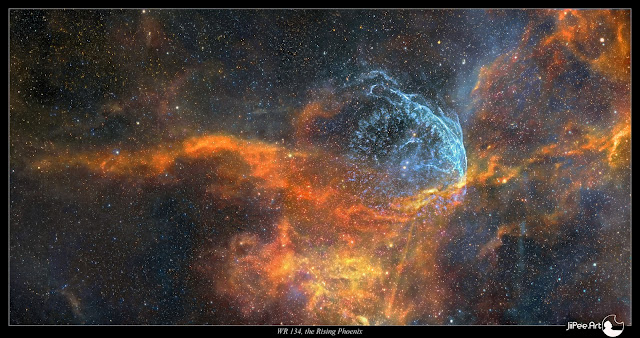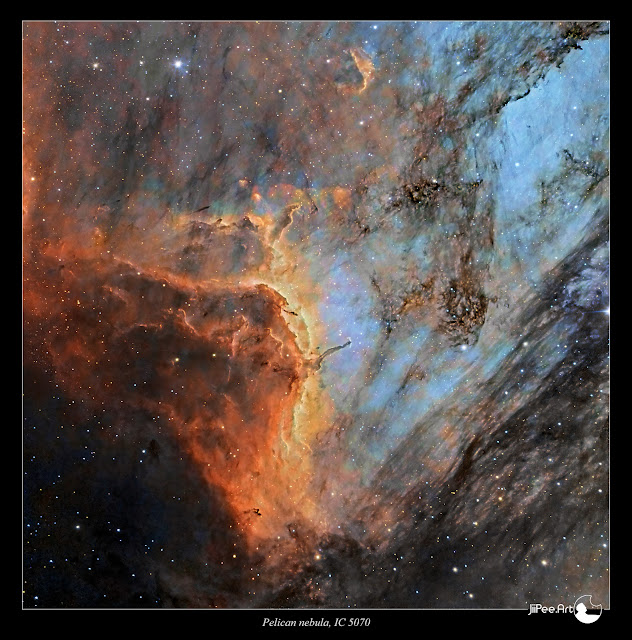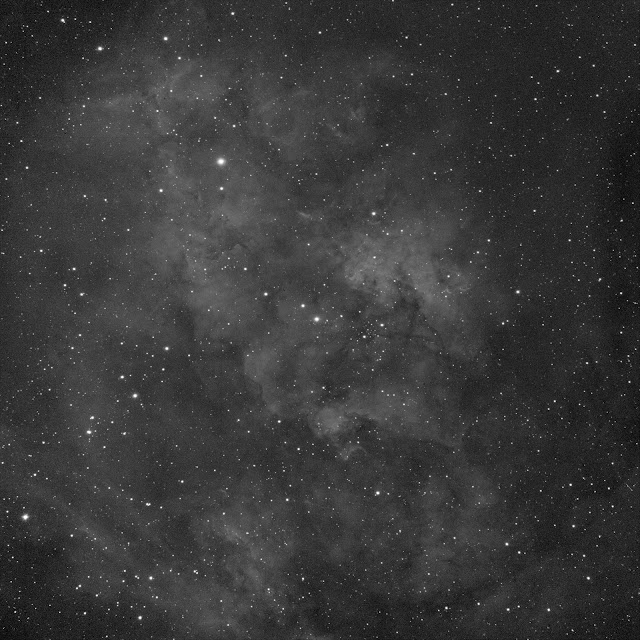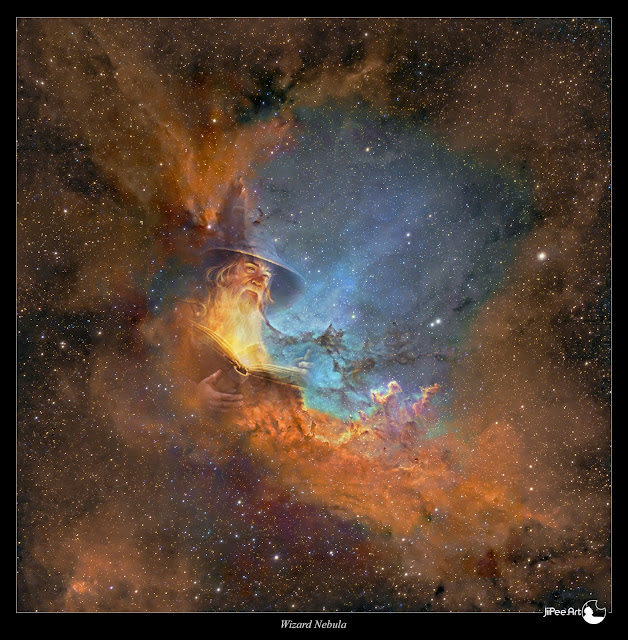COPYRIGHT, PLEASE NOTE
Thursday, December 19, 2024
Pansy of the Swan, Sharpless 112
My previous image was showing the Sharpless 115 an emission nebula area in Cygnus, just next to it lays another Sharpless catalog target, Sh2-112.
My new photo about Sh2-112 has O-III and S-II data from my older image of Sharpless 112 from the October 2015. The new H-alpha data is much deeper and has a higher resolution. For some reason, this target has always been very difficult to process. Details in a background are very diffused and the actual emission nebula has a vast dynamic range, from a very bright to a very dim features.
I renamed this target to a "Pansy of the Swan" since the bright nebula looks like a blooming yellow pansy.
sulfur=red, hydrogen=green and oxygen=blue
sulfur=red, hydrogen=red and oxygen=blue, this combination is very close to a natural color palette.

This is my very large mosaic photo of the whole Cygnus, more info about this massive photo
Sunday, December 15, 2024
New Photo, Sharpless 115 in Cygnus
This Portion of sky covers less than a square degrees of sky in Constellation Cygnus, the Swan.
This star nursery has always looked to me like like it was cut out of the Baroque painting.
I was able to shoot a high resolution data for it with my new imaging setup. The Celestron Edge 14". This telescope has a beautiful optics and with a secondary mirror focuser, it'll hold the collimation perfectly all the time. Normally the heavy main mirror is used for focusing and it can be source of optical problems when it moves due to gravity when the scope is moving and pointing to a different portions of sky.
BAROQUE SKY OF SHARPLESS 115
Click for a full size photo, 2000x2000 pixels
sulfur=red, hydrogen=green and oxygen=blue
Shining with the light of ionized atoms of hydrogen, sulfur, and oxygen in this Hubble palette color composite image, the nebular glow is powered by hot stars in star cluster Berkeley 90. The cluster stars are likely only 100 million years old or so and are still embedded in Sharpless 115. But the stars' strong winds and radiation have cleared away much of their dusty, natal cloud. At the emission nebula's estimated distance, this cosmic close-up spans just under 100 light-years.
Source: NASA APOD
sulfur=red, hydrogen=red and oxygen=blue, this combination is very close to a natural color palette.
This is my very large mosaic photo of the whole Cygnus, more info about this massive photo
Monday, December 9, 2024
Wizard Nebula, NGC 7380
My new setup has a long focal length optics, Celestron EDGE 14", after years of shooting the wider field astronomical photos, it's very nice to dig in to the details of those cosmic wonders.
My new photo shows the Wizard nebula in Cepheus, I have shot this target many times with a various optical configurations. The combination of 14" telescope and large 12 micron pixels of my "new" second hand camera, Apogee Alta U9000M, delivers an optimal resolution to my seeing conditions (0.91 arcsecond/pixel). This makes possible to go very deep in relatively short cumulative exposure time, as can be seen in this photo. A dim background nebulosity stand out nicely after about six hours of H-alpha exposures.
Click for a full size photo, 2000x2000 pixels
sulfur=red, hydrogen=green and oxygen=blue
Click for a full size photo, 2000x2000 pixels
Click for a full size image.
Thursday, November 28, 2024
Beauty and the Beast, Tulip Nebula and a Black Hole
I started to collect exposures for this photo back in 2014, now I have shot new high resolution material for this amazing target with my new imaging platform.
I see several layers in my photos and that makes them to tell a story beyond any imagination.
First
A visual layer, that's naturally very important to me as a visual artist, revealing the hidden cosmic beauty and poetry is my passion.
Second
The physical layer, how emission of the nebulae works, radiation pressure, nuclear fusion of the star, gravitational phenomes, etc... all that is extremely beautiful in its own class.
Third
An existential layer, where we are coming and where we are going in a cosmic scale.
Practically all of the heavier elements in our bodies are coming from supernova explosion's, iron in our blood, oxygen, carbon, etc... We are children of the stars
When our Sun will die after few billion years and turn to a planetary nebula, it'll vaporize the Earth and our remains on it and blows them to the outer space. After aeons our remains are going to end up to a building blocks for a new generation of stars.
We all have been stars and one day we going to be stars again.
BEAUTY AND THE BEAST
Tulip Nebula and a Black Hole
Click the photo to see a high resolution photo, it's worth it
sulfur=red, hydrogen=green and oxygen=blue
Black Hole, Cygnus X-1, in a Close Up of the Full Resolution Photo
Click the photo to see a high resolution photo, it's worth it
The complex and beautiful Tulip Nebula, Sharpless 101, blossoms about 8,000 light-years away toward the constellation of Cygnus the Swan. Ultraviolet radiation from young energetic stars ionizes the atoms and powers the emission from the Tulip Nebula.
Also in the featured field of view is the black hole Cygnus X-1, which is also a microquasar because it is one of strongest X-ray sources in planet Earth's sky. The powerful jets from the black hole can't be seen in this photo since they glow light in X-ray wave length. Faint bluish curved shock front, visible at up center, is coursed by the X-ray jet when it hits to a interstellar gas and dust.
Why we can see the black hole in this image as a star like object?
We can't see the actual black hole but we can see how the material is twirling in the black hole. The speed become so high that the matter starts to turn to an energy emitting light trough the whole spectrum up to X-ray and gamma radiation.
Photo in Visual Colors
Click the photo to see a high resolution photo, it's worth it
sulfur=red, hydrogen=red and oxygen=blue
A single, full scale, 20 min H-alpha exposure, Bin 1x1
Click for a full scale image.
Click for a full scale image.
Saturday, November 23, 2024
Astro Anarchy get published
After about three years without shooting new material from the night sky I'm finally back in business.
I had some health issues and after three operations I'm starting to be good as new again. I have also built a new imaging system, it took about two years to get it up and running.
I was really amazed about the amount of publicity my work got after I publish my first photos from the new setup. Here are some of the publication, couple of them are in finish only, sorry.
"This Astrophotographer Captures the Universe Unlike Anyone Else"
JEREMY GRAY
"Olemme kaikki supernovien lapsia"
https://www.kaleva.fi/olemme-kaikki-supernovien-lapsia-oululainen-tahtik/11396012
Tuesday, October 29, 2024
Methuselah Nebula, MWP1, project finalized
Click for a full size image
A single, full size, 20 min H-alpha and O-III exposure
Click for a full scale image.
Both images below are jpg photos of a single full size, 20 min. FIT-format 16 bit image.
Photos are calibrated with darks and bias corrected flats and are heavily stretched to show even a hint of the actual nebula.
H-alpha
Sunday, October 20, 2024
A start of the new imaging project, MWP1, the Methuselah Nebula
MWP1 ( Motch-Werner-Pakull 1, PN G080.3-10.4, PK 080-10.1) is a very old, dim and diffused planetary nebula in constellation Cygnus, the Swan. It's one of the largest planetary nebula known, it spans about 15 light years of space. The apparent size in the sky is 15.52 x 13,13 arcminutes. (Full moon has a diameter of 30 arcminutes) The estimated age of the nebula is 150.000 years.
MWP1 is a very usually shaped, unusually large, and unusually old, planetary nebulae. The progenitor star is also one of the hottest stars known, so hot it is producing large amounts of X-rays. There are not very many photos out of this difficult target.
This is a start of the imaging project with my new imaging system. So far I have shot 15 hours of light from an ionized oxygen, O-III. I'll shoot two other emission lines, H-alpha and S-II, when ever the weather allows it. The triple ionized oxygen emits blueish light, in this image the O-III emission is colorized to blue. I can produce a real three band color image after I have collected enough light for ionized hydrogen and sulfur.
MWP1, the Methuselah Nebula
Click for a large image
A single full scale 20 min O-III exposure
Click for a full scale image.
Friday, October 18, 2024
NOCTURNE EXIHIBITION
First exhibition for a while, this time in my home town Oulu.
A new Art Gallery, AudioGalleria, has it's second exhibition build around my photos.
The exhibition starts at Saturday19.10 with opening party at 18.00 - 20.00, you all are welcome to enjoy my cosmic nature photographs and complimentary sparkling wine!
Ps.
At Fathers day, Sunday 10.11 at 16.00 I will give a public presentation about my work in Valvesali at down town Oulu. All fathers and other guests are welcome.
After the dry lecture we serve complimentary sparkling wine in nearby AudioGalleria.
Tuesday, October 15, 2024
WR 134, The Rising Phoenix
BUY A POSTER
https://astroanarchy.zenfolio.com/
This is the second light for my new imaging setup, the first light image can be seen HERE
For years I have wanted to shoot a long focal length photo of this amazing mass ejecting star in constellation Cygnus, the Swan. Past five years I have done short focal length imaging with camera optics, now it's time to get closer.
I spent several clear nights to capture light emitted by an ionized elements in this gas formation. (H-alpha, S-II and O-III) For compositional reasons I ended up to a two panel mosaic image. Total exposure time is 23h.
When processing the final image I couldn't be noticing how much this formation looked like a mystical creature, the Phoenix Bird. I rarely use any other than official catalog numbers as a name of my photos but this time I simply had to name this composition to "Rising Phoenix".
When art meets science, the results can be beautiful. It can become something more than either of them on their own can ever be.
WR 134 as a Rising Phoenix
Click for a large image, 2500x1300 pixels photo shows the WR 134 like never seen before.
 The photo is in mapped colors from an ionized elements, H-alpha=green, S-II=red and O-III=blue, Original resolution is 12.000 x 7000 pixels
The photo is in mapped colors from an ionized elements, H-alpha=green, S-II=red and O-III=blue, Original resolution is 12.000 x 7000 pixelsInfo about the WR 134
WR 134 is a variable Wolf-Rayet star located around 6,000 light years away from us in the constellation of Cygnus. It's surrounded by a faint bubble of glowing ionized oxygen, blown out by the intense radiation and fast solar wind from the star. The star has five times the radius of the sun and it's 400,000 times more luminous.
My Wide Field Photo of the Area
Click for a large image, ~2500x2000 pixels
WR 134, the Rising Phoenix in visual spectrum
Click for a large image, ~2500x1300 pixels
Click for a large image
A single, full scale, 20 min O-III exposure
Click for a full scale image.
This is a dim target, 1200s O-III exposure doesn't show much about the O-III formation around the star WR 134.
 This is one of the test shots after the collimation procedure. Exposure time is 1200s with 3nm O-III filter. Image is calibrated with Dark Frame and Bias corrected Flat Frame. Target is WR 134 in Cygnus. Stars are pinpoint from corner to corner. Optical analysis of this frame can be found at end of THIS blogpost
This is one of the test shots after the collimation procedure. Exposure time is 1200s with 3nm O-III filter. Image is calibrated with Dark Frame and Bias corrected Flat Frame. Target is WR 134 in Cygnus. Stars are pinpoint from corner to corner. Optical analysis of this frame can be found at end of THIS blogpost
BUY A POSTER
https://astroanarchy.zenfolio.com/
Wednesday, October 9, 2024
FIRST LIGHT FOR MY NEW IMAGING SETUP
After a couple of years I'm able to publish a bran new photo!
This is a first light to my new imaging setup, it took couple of years to get it up and running.
I selected a relatively bright target since I wanted to test the system as soon as possible. The Pelican Nebula in constellation Cygnus, the Swan, is my first target.
The new system has a focal length of 2730mm with a massive 0.7 focal reducer for the Celestron EDGE 14" telescope. The new camera has 12 micron pixel size and it gives me an image scale of 0.91 arc seconds/pixel. (That's perfect for my seeing conditions.) The field of view spans 46.1 x 46.1 arcminutes of sky. (For a scale, Full Moon covers 30x30 arcminutes of sky)
The native resolution of the Apogee Alta U9000M camera is 3056x3056 pixels. I'm using a stacking method that doubles the measures by using the "Drizzle" while imaging. The final image is then 6112x6112 pixels.
Only five hours of light from an ionized hydrogen (H-alpha) is used for this photo. Other two color channels, O-III and S-II, are borrowed from my older long focal length photo of this target taken with Celestron EDGE 11" telescope.
Pelican Nebula
Click the photo to see a 2000x2000 pixel version

Click the image to see a full size version
This photo is in mapped colors from light from an ionized elements, hydrogen = green, sulfur=red and oxygen=blue. (H-alpha, S-II and O-III)
Click the image to see a full size version, 3056x3056 pixels

























.jpg)



























